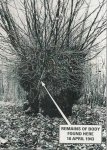I assume it is yatsubusa because Brent identified and sold it as yatsubusa. I think I'd take Brent's ID over someone thinking he or she could ID it from a picture on a website.
Al, these trees from Brent are very big - like 16"+ in height and with 5"+ bases. It probably looks like seiju if you aren't aware of how big the trees are. The leaves on my seijju are probably about a 1/4", while the yatsubusa leaves are a good 1".
You guys throw the word Yatsubusa around like it means something. It is a Japanese word not used in real plant taxonomy and simply means "
small tufts" in Japanese. It is not used in the nursery trade because it has no meaning, any more than nishiki or arakawa. Currently in bonsai the word is used to define a rather "dwarf" species. Hokkaido and Seiju are both considered 'dwarf" species of ulmus.
So you guys seem to be argueing about a mutation of a mutation of a mutation? Ask yourself this can you grow seiju or yatsubusa from seed? What will happen if you plant both in the ground, will they hold true or do the continue to revert to elm foliage?
A mutation becomes a cultivar of the original species. It is propagated ( or
cultivated) by vegetive means only, cutting, grafting, layer. It does not hold true and will revert or suspend mutation over time.
A variety is a plant from a plant that was grown from seed and retains all the caracteristics of the parent plant. It is true to the parent.
This is an acer palmatum. Period. It was grown from seed 35 years ago. Plain old green mountain maple. Hundreds of trees were planted. Most all made green maple palmatums. This is one that became a sport. What do we call it? Maybe a roughbark maple would be a good name. The Japanese word for rough bark is "Arakawa". All cultivars of Acer with rough bark are called Arakawa by the Japanese. It is a cultivar and not a variety. I can reproduce this by cutting and grafting only.





Here is a clump grown from seed with one mutation in the clump. All the same seed but one rough barked tree mutated to add some variety to the clump. Pretty special.

A Mikawa black pine is a
Variety of black pine and holds true to the parent via seed. Nishiki and arakawa are mostly
cultivars, mostly grafted
, and named for their appearence in Japanese nomanclature which means nothing except to those in bonsai.
Now about the elm....you can call it a Yasubusa or Seiju or Hokkaido or whatever, but it is a cultivar of
Ulmus parvifolia. You can't grow Hokkaido nor seiju nor yatsubusa from seed, and all of them over time will throw regular elm foliage from the trunk trying to revert back to the parent. It is perfectly acceptable to consider this tree seiju like in appearence and absolutely nothing to get ones panties in a bunch.












